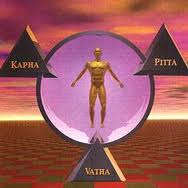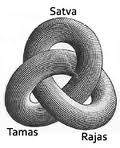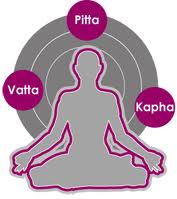Body Types
Ayurvedic Body types
Vata Pitta Kapha

Mental constitution / guna according to Ayurveda
Rajas Tamas Sattva

Ayurvedic Body types are not easy to pick, despite what you might read in books.
Traditionally their are seven different body-types in Ayurveda. The Dosha is determined at time of conception and does never change!
Vata, Pitta, Kapha, Vata-Pitta, Vata-Kapha, Pitta-Kapha and Vata-Pitta-Kapha. More modern advocates of Ayurveda tend to describe people according to their predominant Dosha for example Pitta-Vata instead of Vata-Pitta. But traditionally their is no difference.
Extreme trauma at birth or in the early childhood can give such a shock to the system that the body might disguise itself as another body type and take on other features to protect itself.
Only a experienced Ayurvedic Therapist will be able to accurately determine your body constitution (Dosha or Prakriti). He/She will also be able to determine any imbalance (Vikriti) that is present.
You might think someone is Vata only because they look very slim, but they could have a very longstanding Vata imbalance and might have lost weight at some stage in their life.
This page is not intended to determine your Prakriti or Vikriti, it is just here to give you some better understanding of basic principles in Ayurveda.
Get a ayurvedic consultation with a qualified practitioner

VATA
Is generally thin and doesn’t gain weight easily.
Is quick and active.
Has dry skin more so in winter.
Cold Hands and feet.
The energy fluctuates and comes in bursts.
Tends to have gas or constipation
Has usually difficulty falling asleep or having a sound night’s sleep.
Is uncomfortable in cold weather.
Is lively and enthusiastic.
Has difficulty memorizing things and remembering them later.
Not good at making decisions.
Is anxious or worrisome by nature.
Is talkative and talks quickly.
Is usually emotional and moods fluctuate easy.
The mind is restless, but very imaginative.
Has irregular eating and sleeping habits.
The Vata principle
includes the complete nervous system, some aspects of the endocrine glandular system which coordinate the metabolism and most of the sense organs. Vata structures and functions are responsible for all the communications within the human being as well as the communication with the outer universe. Vata also deals with transports and movements with in a person’s body and mind. Vata entities are responsible for the pumping action of the heart, the breathing process in the lungs, the peristaltic movement of the intestines, and all the movements of the bones and muscles.
Vata dosha is also responsible for mental functions like intuition, imagination, resilience, sensitivity spontaneity, indecisiveness and emotions like exhilaration, fear, insecurity and doubt. In lay terms Vata represent the biological principles of air and space. Vata structures and functions usually have qualities like dry, cold, light, quick, rough, unstable and subtle.
Tips for balancing Vata
Emphasize a diet which is Vata-pacifying
Drink warming herb teas and warm fluids
Avoid alcohol and coffee
Rest adequately
Use sesame oil for a whole body massage in the morning
Take a warm bath or shower
Avoid over stimulation
Keep warm
Do calming exercise like walking, Tai Chi and Yoga
PITTA
Doesn’t tolerate hot weather well
Sweat easily
Can’t tolerate delaying or skipping a meal
Has fine, straight, light, blond, red graying early hair or balding
Has good appetite and likes big meals
Has regular bowel movements rather on the loose side.
Likes cold drinks and foods
Feels hot easily
Can’t tolerate spicy, hot foods easy
Is efficient, organized and accurate
Has strong will and tends to be stubborn
Is impatient by nature
Tends to become irritable or angry quite easily
Tries to be meticulous and to be a perfectionist
Is critical of self and others
The Pitta principle
includes all the digestive enzymes secreted within our gastrointestinal system, the cellular enzymes and the stimulating hormones. Pitta structures and functions are responsible for all the digestion, absorption, assimilation, heat regulation, sweating and metabolism going on in the body and the mind. It also governs skin complexion, visual perception and the process of understanding. The primary location is the Small Intestine.
Pitta dosha is responsible for mental functions like intelligence, confidence, enterprise, organization and emotions like joy, excitement, courage, anger jealousy and hatred. Pitta may be described as the biological principle of fire and water. The structures and functions of Pitta have qualities like hot, moist, light, fluid, sour smelling, sharp and penetrating.
Tips for balancing Pitta
Emphasize Pitt-pacifying diet
Eat whenever hungry
Eliminate aggravated Pitta by a gentle laxative treatment
Avoid exertion
Avoid overexposure to heat and sun
Stay in a cooling environment
Relax in natural surroundings
Do cooling exercises like swimming or walking in cooler weather
KAPHA
Can gain weight easily, loosing weight is difficult
Can skip meals easily
Tend to have congestion, mucus or sinus problems
Has a deep sleep
Has thick, oily, dark, or wavy hair
Has smooth and soft skin with pale complexion
Has a large body frame with a heavy bone structure
Has a slow digestion and feels full after eating
Has a steady energy level and strong stamina
Is sensitive to cool and damp weather
Tends to be slow, methodical and relaxed
Needs at least 10 hrs sleep
Is calm and composed by nature
Learns slower with good memory
Works slow and consistent
Does not like responsibility
The Kapha principle
Structures and functions are responsible for the growth, stability, lubrication and storage within the body. Kapha includes the musculoskeletal frame, composition of all joints, the process of tissue building, wound healing and different accumulations. Kapha dosha is also responsible for mental functions like memory, tranquility, faith, forgiveness, devotion and emotions like love, affection, calmness, patience, sympathy, attachment, reed and lethargy. The primary location is the Stomach.
Kapha is the biological principle of water and earth. The Kapha structures and functions have qualities like heavy, cold, wet, slow, steady, soft oily, sweet and smooth.
Tips for balancing Kapha
Emphasize a diet which is Kapha-pacifying
Reduce sugars and sweets
Drink warming fluids
Keep warm
Avoid cold and damp
Stimulate with a full body dry massage
Accept motivating challenges
Do vigorous exercises like aerobic, tennis, Astanga Yoga etc. regular
The Mental Constitution
The state of the mind is a very important aspect of a person. The ‘rshis’ (sages) understood that everything in this world has got three principal modes. The tendency to act, rest and balance is within all living entities. Rajas, Tamas and Satwa (together known as the tri-gunas) are the tree modes of the universe inherent in every particle, without which we can’t excist. Generally these three modes are applied to understanding the mind, since the mind is the more subtle aspect of our body.
The three modes are not permanent. They are changeable according to our association and action. One can change the modes of mind through constant practice. We can evolve from rajas or tamas to satwa, the balance and harmony, through acute self awareness, humility and diligence. A well balanced male should have 70% satva, 20% rajas and 10% tamas. A well balanced female should have 70% satva, 10% rajas and 20% tamas. While a true guru would be 100% sattwig.
To determine your current predominant mental state look at the following:

Satva Rajas Tamas
Mental Clarity Very clear Hyperactive Cloudy
Concentration Good Moderate Poor
Memory Good Moderate Poor
Will power Strong Variable Weak
Honesty Always Mostly Rarely
Peace of mind Generally Occasionally Rarely
Creativity High Moderate Low
Spiritual study Daily Occasionally Never
Mantra/Prayer Daily Occasionally Never
Meditation Daily Occasionally Never
Selfless service Often Occasionally Rarely
Relationships Harmonious Passionate Disturbed
Anger Rarely sometimes Frequently
Fear Rarely Sometimes Frequently
Desire Little some Uncontrollable
Pride Modes some ego Vain
Depression Never Sometimes Frequently
Love Universal Personal Lacking in love
Violent Behaviour Never Sometimes Frequently
Attachment Detached Occasionally Attached
Forgiveness Forgive easily With effort grudges
Diet Vegetarian some meat frequent meat
Addictive behaviour Never occasionally frequently
Sensory impression Calm mixed disturbed
Sleep requirement Little moderate excessive
Sexual activity Controlled intense uncontrollable
Control of senses Good moderate low
Speech Peaceful agitated dull
Cleanliness High moderate low
Work Selfless reward centred aimless
Satwa
is exemplified by balance and harmony. It is the state of harmony, discrimination, stability of mind, efficiency of handling matters without partiality and selfishness, emotional stability and detachment.
Satwic people tend to have an inherent instinct for cleanliness and possess and effortless wisdom reflected in their action. they don’t tend to worry, be anxious or panic. They do things in a systematic, intelligent and peaceful way.
Satwa is the peaceful, calm state of mind exemplified by the world’s saintly people. When satwa declines we resort to rajas or tamas, depending upon the person’s activities.
Rajas
is the inherent tendency to be active. This is essential to get things done. when excessive, Rajas results in hyperactivity, aggression, passion, severe attachment, agitation and regrettable actions. When unbalanced rajas is considered a disturbing influence on the mind.
Rajasic people tend to be power hungry and dissatisfied with what positions or possessions they obtain, they are constantly striving for more often at the cost of those around them. They have a brave yet jealous and cruel character.
Tamas
presents as inertia. Rest or sleep is impossible without this quality. It provides grounding and stability. Its increase results in inertia, laziness, apathy, ignorance and depression. Excessive tamas is darkness.
Tamasic people tend to avoid work, with a penchant for uncontrolled sense gratification and wasting time. They avoid cleanliness and are not health conscious. They are the most prone to phobia and procrastination.
Ref From : http://www.naturaltherapyinfo.com


Quick Links
- Home
- About Us
- Water Element- Self Urine Therapy
- About Urine Therapy
- Introduction
- Urine Test
- Scientific Information
- How to Do Urine Therapy
- Information on Urine Therapy
- WORLD CONFERENCE ON URINE THERAPY
- VDO on 6th world conference
- HEALTH CENTERS AND WEB SITES ON UT
- BOOKS ON URINE THERAPY
- AUDIO ON URINE THERAPY
- VIDEO ON URINE THERAPY
- PICTURES on UT
- Urine Therapy Federation of India
- Members of UTFI
- Pictures UTFI
- SELF EXPERIENCES & CASE HISTORY
- Common Questions
- Urine Therapy By
- Natural Healing by Sunil Munot
- UT BY COEN VAN DER KROON
- UT BY MARTHA CHRISTY
- UT BY MARTIN J LARA
- UT BY SWAMI SATYANANDA SARASWATI
- UT BY DEVENDRA VORA, M.D.
- UT by Mike Crowley
- UT By Renee Sunsprit
- UT BY NATALIA PERERA
- UT BY FLORA PESCHEK-BÖHMER PH.D.
- UT BY BIOMEDX
- UT BY DR.G.K.THAKKAR – SHIVAMBU GITA
- UT BY SHIRLEYSWELLNESSCAFE.COM
- UT BY JOHN F. KELLY
- UT BY AHMEN HEAVEN
- UT BY AGAMA YOGA
- UT BY WALTER LAST
- UT BY ALLDEAF.COM
- UT By Cameron Karsten
- Ut by Damar Tantra
- UT By Tony Scazzero
- UT Information by Don Orina
- Best Drinking Water
- SEA WATER
- About Urine Therapy
- Earth Element
- Fire Element
- Air Element
- Sky Element
- Sixth Element
- Chronic Diseases
- Cleaning Elements
- Important links
- Jain links
- Visitors Mail
- Gallery
- Video
- Our Inspiration
- Contribution
- Contact Us

